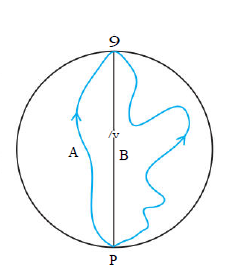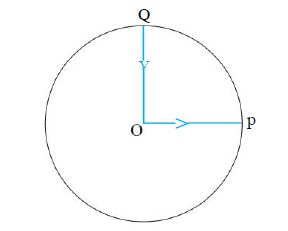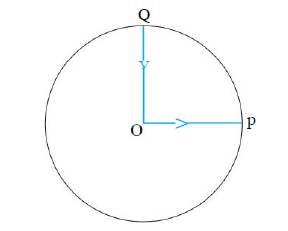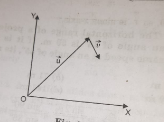Complete Solutions to EXAMPLE of chapter MOTION IN A PLANE of Class 11 book with complete answers and questions
| Class 11 | PHYSICS |
| Chapter | MOTION IN A PLANE |
| MBD | EXAMPLE |
| Number Of Questions | 100 |
| Academic Year | 2023-24 |
What do you mean by null vector?
01:06View SolutionDefine equal vectors.
01:45View SolutionDefine negative vectors.
02:18View SolutionDefine unit vector.
01:42View SolutionExpress the unit vector `hatA` mathematical form
01:21View SolutionWhat are scalar quantities?
01:24View SolutionWhat are vector quantities?
01:40View SolutionWhat is the resultant vector?
01:31View SolutionCan the magnitude of the resultant vector of te two given vectors is less than the magnitude of any of the given vectors?
02:00View SolutionDisplacement vector is fundamentally a position? Comment on this statement.
02:15View SolutionCan we multiply a vector by a real number?
01:21View SolutionPick out the only vector quantity in the following list : Temperature, pressure, impulse, time, power, total path length, energy, gravitational potential, coefficient of friction, charge.
01:40View SolutionIs pressure a vector qantity?
01:51View SolutionVectors cannot be added algebraically. Why?
01:18View SolutionUnder what conditions, the direction of sum and difference of two vectors will be the same?
01:49View SolutionGive an example of motion in two dimensions.
01:21View SolutionGive an example of motion in three dimensions.
01:32View SolutionCan a body be accelerate without speeding up or slowing down?
01:24View SolutionIs it possible to accelerate a body if its speed is constant?
01:44View SolutionCan a body have a constant velocity but varying speed?
01:20View SolutionCan the velocity of a particle vary even if speed is constant?
02:00View SolutionDefine three dimensional motion.
02:00View SolutionWhen will you say a body is in : uniform acceleration ?
02:32View SolutionIs the rocket in flight an illustration of a projectile?
01:20View SolutionA person sitting in a moving train throws a ball vertically upwards. How does the ball appear to move to an observer inside the train
01:40View SolutionA person sitting in a moving train throws a ball vertically upwards. How does the ball appear to move to an observer outside the train?
01:36View SolutionA projectile is projectile at an angle of `15^@` to te horizontal with speed v. if another projectile is rojected with the same speed, then at what angle with the horizontal it must be projected so as to have the same range.
02:18View SolutionKeeping the angle of projection same, what is the effect on horizongal range of a projectile when its velocity is doubled?
01:37View SolutionAt what points on the projectile trajectory is the speed minimum
01:55View SolutionAt what points on the projectile trajectory is the speed maximum
01:42View SolutionA ballon is ascending at the rate of `14 ms^-1` at a height of 98 m above ground when a packet is dropped from the balloon. After how much time and with what velocity does it reach the ground.
02:27View SolutionWhy the motion of oblique projectile becomes horizontal at the highest point?
01:34View SolutionAt what point on the projectile trajectory is the potential energy maximum
01:27View SolutionAt what point on the projectile trajectory is the kinetic energy minimum
01:31View SolutionAt what point on the projectile trajectory is the total energy is maximum?
01:36View SolutionState, for each of the following physical quantities, if it is a scalar or a vector : volume, mass, speed, acceleration, density, number of moles, velocity, angular frequency, displacement, angular velocity.
08:42View SolutionPick out the two scalar quantities in the following list : force, angular momentum, work, current, linear momentum, electric field, average velocity, magnetic moment, relative velocity.
07:46View SolutionPick out the only vector quantity in the following list : Temperature, pressure, impulse, time, power, total path length, energy, gravitational potential, coefficient of friction, charge.
01:40View SolutionState with reasons, whether the following algebraic operations with scalar and vector physical quantities are meaningful :- adding any two scalars,
02:27View SolutionState with reasons, whether the following algebraic operations with scalar and vector physical quantities are meaningful :- adding a scalar to a vector of the same dimensions
02:24View SolutionState with reasons, whether the following algebraic operations with scalar and vector physical quantities are meaningful :- multiplying any vector by any scalar,
01:58View SolutionState with reasons, whether the following algebraic operations with scalar and vector physical quantities are meaningful :- multiplying any two scalars,
02:11View SolutionState with reasons, whether the following algebraic operations with scalar and vector physical quantities are meaningful :- adding any two vectors,
03:06View SolutionRead each statement below carefully and state with reasons, if it is true or false :- The magnitude of a vector is always a scalar,
02:28View SolutionRead each statement below carefully and state with reasons, if it is true or false :- each component of a vector is always a scalar,
01:42View SolutionRead each statement below carefully and state with reasons, if it is true or false :- the total path length is always equal to the magnitude of the displacement vector of a particle,
04:07View SolutionRead each statement below carefully and state with reasons, if it is true or false:
the average speed of a particle is either greater than or equal to the magnitude of average velocity of the particle over the same interval of time.02:36View SolutionRead each statement below carefully and state with reasons, if it is true or false :- Three vectors not lying in a plane can never add up to give a null vector.
03:25View SolutionGiven `vec a + vec b + vec c+ vec d= 0`, which of the following statements are correct:
08:47View SolutionThree girls skating on a circular ice ground of radius 200 m start from a point P on the edge of the ground and reach a point Q diametrically opposite to Pfollowing different paths as shown in Fig. 4.20. What is the magnitude of the displacement vector for each ? For which girl is this equal to the actual length of path skate?
 02:22View Solution
02:22View SolutionA cyclist starts from the centre Oof a circular park of radius 1 km, reaches the edge P of the park, then cycles along the circumference, and returns to the centre along QO as shown in Fig. 4.21. If the round trip takes 10 min, what is the:- net displacement,
 02:18View Solution
02:18View SolutionA cyclist starts from the centre Oof a circular park of radius 1 km, reaches the edge P of the park, then cycles along the circumference, and returns to the centre along QO as shown in Fig. 4.21. If the round trip takes 10 min, what is the:- average velocity, and
 01:43View Solution
01:43View SolutionA cyclist starts from the centre Oof a circular park of radius 1 km, reaches the edge P of the park, then cycles along the circumference, and returns to the centre along QO as shown in Fig. 4.21. If the round trip takes 10 min, what is the:- average speed of the cyclist ?
 06:11View Solution
06:11View SolutionOn an open ground, a motorist follows a track that turns to his left by an angle of `60^@` after every 500 m. Starting from a given turn, specify the displacement of the motorist at the third, sixth and eighth turn. Compare the magnitude of the displacement with the total path length covered by the motorist in each case.
06:00View SolutionA passenger arriving in a new town wishes to go from the station to a hotel located 10 km away on a straight road from the station. A dishonest cabman takes him along a circuitous path 23 km long and reaches the hotel in 28 min. What is:- the average speed of the taxi,
03:43View SolutionA passenger arriving in a new town wishes to go from the station to a hotel located 10 km away on a straight road from the station. A dishonest cabman takes him along a circuitous path 23 km long and reaches the hotel in 28 min. What is:- the magnitude of average velocity ? Are the two equal ?
06:25View SolutionRain is falling vertically with a speed of `30 ms^-1`. A woman rides a bicycle with a speed of `10 m s^-1` in the north to south direction. What is the direction in which she should hold her umbrella ?
05:05View SolutionA man can swim with a speed of `4.0 km//h` in still water. How long does he take to cross a river 1.0 km wide if the river flows steadily at `3.0 km//h` and he makes his strokes normal to the river current? How far down the river does he go when he reaches the other bank ?
02:51View SolutionIn a harbour, wind is blowing at the speed of `72 km//h` and the flag on the mast of a boat anchored in the harbour flutters along the N-E direction. If the boat starts moving at a speed of `51 km//h` to the north, what is the direction of the flag on the mast of the boat ?
07:06View SolutionTire ceiling of a long hall is 25 m high. What is the maximum horizontal distance that a ball thrown with a speed of `40 m s^-1` can go without hitting the ceiling of the hall ?
05:33View SolutionA cricketer can throw a ball to a maximum horizontal distance of 100 m. How much high above the ground can the cricketer throw the same ball ?
04:36View SolutionA stone tied to the end of a string 80 cnr long is whirled in a horizontal circle with a constant speed. If the stone makes 14 revolutions in 25 s, what is the magnitude and direction of acceleration of the stone ?
05:23View SolutionAn aircraft executes a horizontal loop of radius 1.00 knr with a steady speed of `900 km//h`. Compare its centripetal acceleration with the acceleration due to gravity.
04:29View SolutionRead each statement below carefully and state, with reasons, if it is true or false :- The net acceleration of a particle in circular motion is always along the radius of the circle towards the centre
01:52View SolutionRead each statement below carefully and state, with reasons, if it is true or false :- The velocity vector of a particle at a point is always along the tangent to the path of the particle at that point
02:02View SolutionRead each statement below carefully and state, with reasons, if it is true or false :- The acceleration vector of a particle in uniform circular motion averaged over one cycle is a null vector
02:34View SolutionThe position of a particle is given by `r=3.0t hati - 2.0t^2 hatj + 4.0 hatk m` where tis in seconds and the coefficients have the proper units for r to be in metres:- Find the v and a of the particle?
05:15View SolutionThe position of a particle is given by `r=3.0t hati - 2.0t^2 hatj + 4.0 hatk m` where tis in seconds and the coefficients have the proper units for r to be in metres:- What is the magnitude and direction of velocity of the particle at t = 2.0 s ?
07:00View SolutionA particle starts from the origin at t = 0 s with a velocity of `10.0 hatj m//s` and moves in the x-y plane with a constant acceleration of `(8.0hati + 2.0hatj) m s^-2`,:- At what time is the x- coordinate of the particle 16 m? What is the y-coordinate of the particle at that time?
08:50View SolutionA particle starts from the origin at t = 0 s with a velocity of `10.0 hatj m//s` and moves in the x-y plane with a constant acceleration of `(8.0hati + 2.0hatj) m s^-2`,:- What is the speed of the particle at the time ?
06:07View Solution`hati and hatj` are unit vectors along x- and y- axis respectively. What is the magnitude and direction of the vectors `hati + hatj, and hati- hatj` ? What are the components of a vector `A= 2 hati + 3hatj` along the directions of `hati + hatj and hati- hatj`? [You may use graphical method]
10:11View SolutionFor any arbitrary motion in space, which of the following relations are true :- `v_average=(1/2) (v(t_1))+(v(t_2))`(The ‘average’ stands for average of the quantity over the time interval `t_1 to t_2`)
02:56View SolutionFor any arbitrary motion in space, which of the following relations are true :-`v_average=[r(t_2)-r(t_1)/(t_2-t_1)`(The ‘average’ stands for average of the quantity over the time interval `t_1 to t_2`)
02:38View SolutionFor any arbitrary motion in space, which of the following relations are true :- `v(t)=v(O)+a t`(The ‘average’ stands for average of the quantity over the time interval `t_1 to t_2`)
02:30View SolutionFor any arbitrary motion in space, which of the following relations are true :- `r(t)=r (O)+v(O) t+(1/2) a t^2`(The ‘average’ stands for average of the quantity over the time interval `t_1 to t_2`)
03:12View SolutionFor any arbitrary motion in space, which of the following relations are true :- `a_averag[v(t_2)-v(t_1)]/(t_2-t_1)`(The ‘average’ stands for average of the quantity over the time interval `t_1 to t_2`)
02:58View SolutionRead each statement below carefully and state, with reasons and examples, if it is true or false :-A scalar quantity is one that:- is conserved in a process
02:40View SolutionRead each statement below carefully and state, with reasons and examples, if it is true or false :-A scalar quantity is one that:- can never take negative values
01:59View SolutionRead each statement below carefully and state, with reasons and examples, if it is true or false :- A scalar quantity is one that:- must be dimensionless
03:45View SolutionRead each statement below carefully and state, with reasons and examples, if it is true or false :- A scalar quantity is one that:- does not vary from one point to another in space
02:28View SolutionRead each statement below carefully and state, with reasons and examples, if it is true or false :- A scalar quantity is one that:- has the same value for observers with different orientations of axes.
02:18View SolutionAn aircraft is flying at a height of 3400 m above the ground. If the angle subtended at a ground observation point by the aircraft positions 10.0 s apart is `30^@`, what is the speed of the aircraft ?
06:46View SolutionA vector has magnitude and directions.Does it have a location in space? Can it vary with time ? Will two equal vectors `veca` and `vecb` at different locations in space necessarily have identical physical effects? Give examples in supports for your answer.
03:52View SolutionA vector has both magnitude and direction. Does it mean that anything that has magnitude and direction is necessarily a vector ?The rotation of a body can be specified by the direction of the axis of rotation, and the angle of rotation about the axis. Does that make any rotation a vector ?
03:17View SolutionCan you associate vectors with:- the length of a wire bent into a loop, Explain.
02:07View SolutionCan you associate vectors with:- a plane area, Explain.
02:57View SolutionCan you associate vectors with:-a sphere ? Explain.
01:54View SolutionA bullet fired at an angle of `30^@` with the horizontal hits the ground 3.0 km away. By adjusting its angle of projection, can one hope to hit a target 5.0 km away ? Assume the muzzle speed to be fixed, and neglect air resistance.
04:01View SolutionA fighter plane flying horizontally at an altitude of 1.5 km with speed `720 km//h` passes directly overhead an anti-aircraft gun. At what angle from the vertical should the gun be fired for the shell with muzzle speed `600 m s^-1` to hit the plane ? At what minimum altitude should the pilot fly the plane to avoid being hit ? (Take g = `10 ms^2`).
06:38View SolutionA cyclist is riding with a speed of `27 km//h`. As he approaches a circular turn on the road of radius 80 m, he applies brakes and reduces his speed at the constant rate of `0.50 m//s` every second. What is the magnitude and direction of the net acceleration of the cyclist on the circular turn ?
04:05View SolutionShow that for a projectile the angle between the velocity and the x-axis as a function of time is given by
`theta(t) = tan^(-1) [(v_(oy)-g t)/(v_(o x))]`05:42View SolutionShows that the projection angle `theta_o` for a projectile launched from the origin is given by `theta_o=tan^-1((4h_m)/R)` where the symbols have their usual meaning.
02:42View SolutionThe angle between `(hati + hatj)` and `(hati - hatj)` is
02:21View Solutionf and h are function from A `rarr` B, where A = {a, b, c, d} and B = {s, t, u} defined as follows
f(a) = t, f (b) = s, f(c ) = s
f(d) = u, h(a) = s, h(b) = t
h(c ) = s, h(a) = u, h(d) = u
Which one of the following statement is true?04:57View SolutionShown in the figure the orientation of two vectors `vecu`and `vecv` in the xy plane
if `vecu = ahati+bhatj` and
`vecv= phati+qhatj`
which of the following is correct?
 02:26View Solution
02:26View SolutionThe component of a vector `hatr` along x-axis will have maximum value if
01:39View SolutionThe horizontal range of a projectile fired at an angle of `15^@` is 50 m. If it is fired at an angle of `45^@`, what will be its range?
01:56View SolutionConsider the quantities,pressure,power,energy,impulse,gravitational potential,electrical charge,temperature,area.Out of these, the only vector quantities are:
02:38View SolutionIn a two dimensional motion,instantaneous speed `v_0` is a positive constant.Then which of the following are necessarily true?
03:02View SolutionThree vectors `vecA, vecB ` and `vecC` add up to zero. Find which is false.
08:49View Solution
EXAMPLE questions and complete solutions for chapter MOTION IN A PLANE of MBD of Class 11
